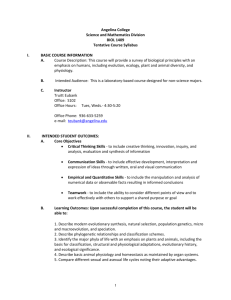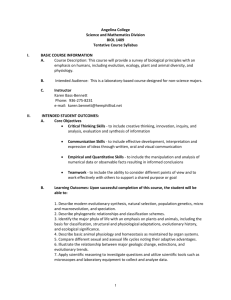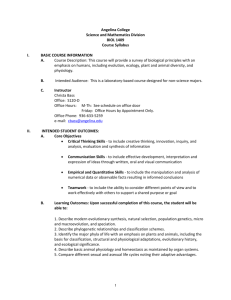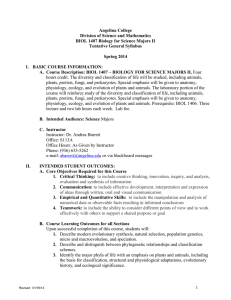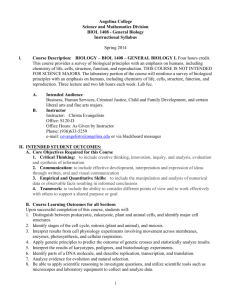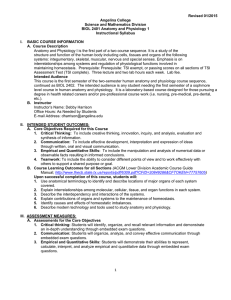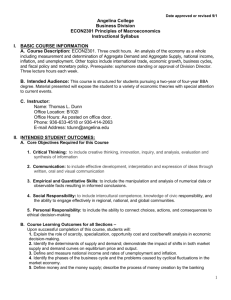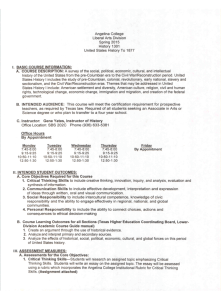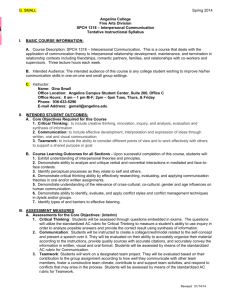Syllabus - Angelina College
advertisement
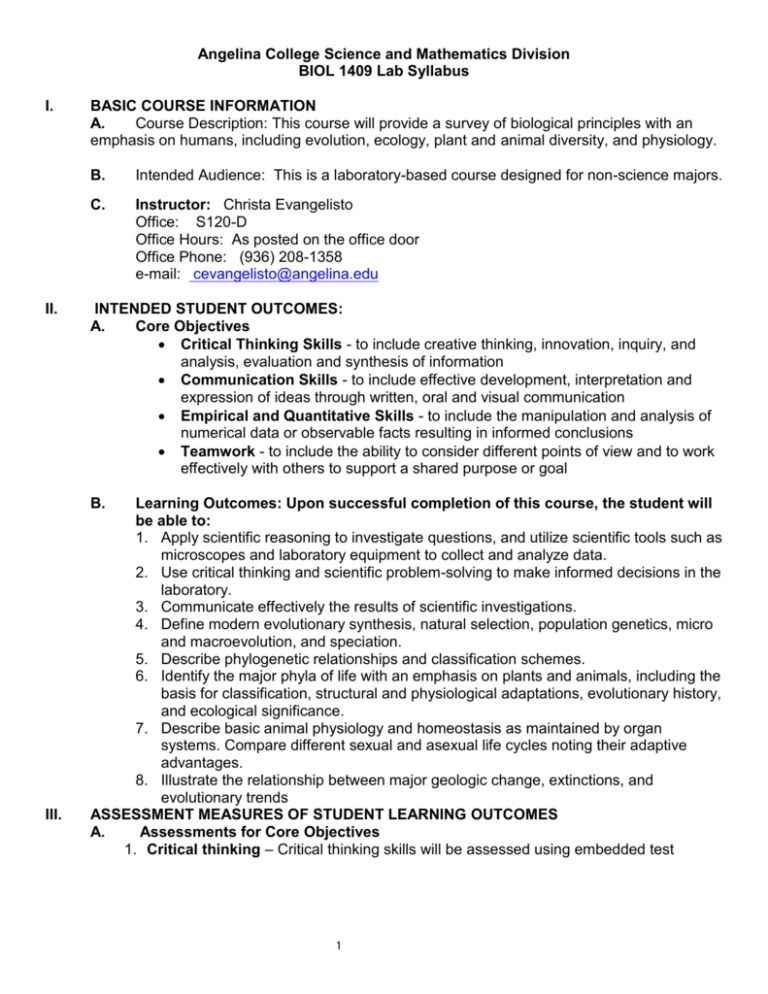
Angelina College Science and Mathematics Division BIOL 1409 Lab Syllabus I. II. BASIC COURSE INFORMATION A. Course Description: This course will provide a survey of biological principles with an emphasis on humans, including evolution, ecology, plant and animal diversity, and physiology. B. Intended Audience: This is a laboratory-based course designed for non-science majors. C. Instructor: Christa Evangelisto Office: S120-D Office Hours: As posted on the office door Office Phone: (936) 208-1358 e-mail: cevangelisto@angelina.edu INTENDED STUDENT OUTCOMES: A. Core Objectives Critical Thinking Skills - to include creative thinking, innovation, inquiry, and analysis, evaluation and synthesis of information Communication Skills - to include effective development, interpretation and expression of ideas through written, oral and visual communication Empirical and Quantitative Skills - to include the manipulation and analysis of numerical data or observable facts resulting in informed conclusions Teamwork - to include the ability to consider different points of view and to work effectively with others to support a shared purpose or goal B. III. Learning Outcomes: Upon successful completion of this course, the student will be able to: 1. Apply scientific reasoning to investigate questions, and utilize scientific tools such as microscopes and laboratory equipment to collect and analyze data. 2. Use critical thinking and scientific problem-solving to make informed decisions in the laboratory. 3. Communicate effectively the results of scientific investigations. 4. Define modern evolutionary synthesis, natural selection, population genetics, micro and macroevolution, and speciation. 5. Describe phylogenetic relationships and classification schemes. 6. Identify the major phyla of life with an emphasis on plants and animals, including the basis for classification, structural and physiological adaptations, evolutionary history, and ecological significance. 7. Describe basic animal physiology and homeostasis as maintained by organ systems. Compare different sexual and asexual life cycles noting their adaptive advantages. 8. Illustrate the relationship between major geologic change, extinctions, and evolutionary trends ASSESSMENT MEASURES OF STUDENT LEARNING OUTCOMES A. Assessments for Core Objectives 1. Critical thinking – Critical thinking skills will be assessed using embedded test 1 questions focusing on analysis, synthesis and evaluation of biological phenomena. 2. Communication – Communication skills will be assessed using lab reports and embedded test questions focusing on best practices in written, visual, and oral communication. 3. Empirical and Quantitative Skills – Empirical and quantitative skills will be introduced and assessed using embedded test questions focusing on calculations in genetics and population dynamics. 4. Teamwork – Teamwork skills will be assessed using teamwork skills in lab exercises as well as embedded test questions focusing on best practices. B. Learning Outcomes 1. Students will apply scientific reasoning to investigate questions, and utilize scientific tools such as microscopes and laboratory equipment to collect and analyze data through individual and group activities in the laboratory. 2. Students will use critical thinking and scientific problem-solving to make informed decisions in the laboratory. 3. Students will communicate effectively the results of scientific investigations by completing conclusion questions at the end of each lab and responding to questions on exams. 4. Define modern evolutionary synthesis, natural selection, population genetics, micro and macroevolution, and speciation. 5. Students will describe phylogenetic relationships and classification schemes in lab activities and by answering questions on lab exams. 6. Students will identify the major phyla of life with an emphasis on plants and animals, including the basis for classification, structural and physiological adaptations, evolutionary history, and ecological significance in lab activities and by answering questions on lab exams. 7. Students will describe basic animal physiology and homeostasis as maintained by organ systems in lab activities and by answering questions on lab exams. 8. Students will compare different sexual and asexual life cycles noting their adaptive advantages in lab activities and by answering questions on lab exams. 9. Students will illustrate the relationship between major geologic change, extinctions, and evolutionary trends in lab activities and by answering questions on lab exams. IV. INSTRUCTIONAL PROCEDURES A. Methodologies common to all sections This course will be taught using a combination of lectures and laboratory exercises that complement and supplement lecture material. Audio-visual materials, models, and dissection of specimens will be employed to enhance lecture and lab experiences. V. COURSE REQUIREMENTS AND POLICIES A. Required Textbooks and Equipment 1. Campbell biology Concepts & Connections (Pearson), 8th ed. 2. Access to www.pearsonmylabsandmastering.com (access code available with the textbook from the publisher) 3. Access to www.angelina.blackboard.com. 4. Scantrons for exams. 2 B. Course Policies – (This course conforms to the policies of Angelina College as stated in the Angelina College Handbook.) Academic Assistance – If you have a disability (as cited in Section 504 of the Rehabilitation Act of 1973 or Title II of the Americans with Disabilities Act of 1990) that may affect your participation in this class, you should see Karen Bowser, Room 208 of the Student Center. At a post –secondary institution, you must self-identify as a person with a disability; Ms. Bowser will assist you in with the necessary information to do so. Attendance Policy – Attendance will be required as per Angelina College Policy. Records will be turned in to the academic dean at the end of the semester. Do not assume that non-attendance in class will always in an instructor drop. You must officially drop a class or risk receiving a failing grade. This is official Angelina College Policy. The last day to drop the class with a “W” is Nov. 9th. Policies Established by the Instructor STUDENT CONDUCT: A positive environment for learning will be maintained by students being courteous to each other and to the instructor. Eating, drinking, sleeping, and distracting conversations during lecture will not be allowed. Regular attendance is also expected as per college policy. There is no excuse for tardiness as it is rude to the instructor and to students. Be in class on time. Cheating on tests is not tolerated as per Angelina College policy and may result in expulsion from the course. Plagiarism is not tolerated and will result in a zero for any assignment in which it is detected. CELL PHONES: Cell phones must be turned off or on the silent mode. Students may not have access to cell phones during quizzes and/or tests. VI. COURSE OUTLINE Day Date Topic 1 Aug 31 Introduction, Safety, Scientific Method 2 Sep 14 Ecology 3 21 Evolution and Natural Selection 4 28 Classification 5 Oct 5 LAB EXAM 1 6 12 Prokaryotes, protists, fungi 7 19 Plant Diversity 8 26 Plant Anatomy 9 Nov 2 LAB EXAM 2 10 9 Invertebrate Anatomy 11 16 Histology 12 23 Respiratory, Cardiovascular and Digestive Systems Urinary and Reproductive Systems 13 30 Nervous System, Eye Dissection 14 Dec 7 LAB EXAM 3 3 Lab # 1 22, handout 14 handout 15-17 18 19 20 9 10 11 12, handout VII. EVALUATION AND GRADING Grading: Lecture grades will be determined by the total number of points earned from the possible points available. The lecture portion of the course is worth 2/3 of the total course grade. The lab portion of the course is worth 1/3 of the total course grade. Course grades will be determined using the following guidelines: The lecture grade will be calculated based on the points shown below. 4 regular exams 400 points Final exam 100 points Homework/quizzes 100 points The lab grade will be calculated based on the points shown below. 2 lab exams 200 points Lab assignments/quizzes 100 points To calculate your course grade, use the following: Percentage of points from lecture x 0.67 = ______ Percentage of points from lab x 0.33 = ______ Sum of above = ______ = course grade Letter grades will be assigned based on the course grade as calculated above. 90 or above = A 60 – 69 =D 80 – 89 =B 59 or below = F 70 – 79 =C The instructor may modify the provisions of the syllabus to meet individual class needs by informing the class in advance as to the changes being made. 4
